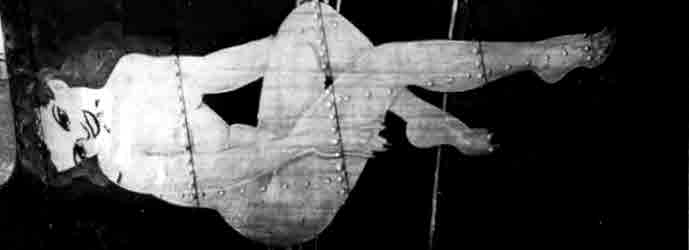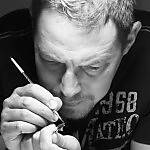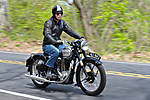Just to prove that I didn't have a coronary while the B-17 fuselage was being closed up, and that there was no disaster in the process, I submit this "hostage photo" of the fuselage following the departure of my NC friend.

It also shows off to reasonable advantage my work table looking far neater than it normally does. The observant will note some Cyrillic script in the center foreground. The newspapers come courtesy of my Russian-American spouse.
Herewith some comments on what happened over the three days my North Carolina friend was here, in which I probably sorely tested his patience more than once.
Basically, and contrary to what I would've done, we started from the front. He did a remarkable job gluing the nose together without the need for any fillers, despite a dramatic gap at the top of the nose. He also did an absolutely spectacular job gluing in and feathering in the four top windows, so that they are absolutely flush with the OD plastic surface of the fuselage itself. You will see later in pictures that I post that he did a similarly great job with the radio room windows, which are absolutely flush with the fuselage sides.
Even more remarkable from my standpoint was his effort in putting the radio room roof in. To do this he had to make a clean join on the fuselage forward to the roof, which was also absolutely remarkable given the gap that existed. However, once again, this was done with no fillers (sheet styrene) at all! Remarkable!
Installing the radio room roof itself was a bear. All I will say here is that his scratch building skills on exterior surfaces allowed him to feather the part in, but that there was an absolute ton of sanding and polishing that was necessary. I was more than impressed.
I would also say that the lower fuselage joined up beautifully too.
This leaves discussion of the cockpit roof. The gray roof you see in the picture is not his work. Here's what happened.
First, we looked at both the Verlinden aftermarket brass framework and the Eduard to explore the possibility of opening up the cockpit windows.
Ultimately, we settled on the Verlinden brass parts because they seem to offer a more manageable way of positioning windows open. However, and this is where my persnickety-ness comes in, when all was said and done the damn window frameworks and brass were too tall. They also required that the original kit part dedicated to this roof be modified. Even then, and after a ton of feathering and standing by my North Carolina friend, the roof sat a bit too high and the front was slightly sloped up.
Another issue dealt with the use of future on clear styrene windows not clearing up, because of the lack of "breathing space" between panes that were close together. When I still had fog a day or two after the work was done I grit my teeth and ripped the whole thing out. (Yeah, I'm like that. Remember the nose installation
 )
)So, take it from a couple of builders who have tried to use the Verlinden brass here. "It ain't worth it."
Sadly, I also have a similar verdict on the Edward brass set for the cockpit windows. This one isn't designed to allow you to position the windows open, and instead the framework brass parts are supposed to fit over the engraved plastic parts. But, inexplicably, these damn things are too big too! I have no idea why they are oversized, but they are. They simply do not fit the frames on the kit canopy part.
The only parts of this set I may use on the build are the brass coamings around the top windows, but that also remains to be seen.
Anyway, this weekend I should have the kit glass glued into the front of the roof part, followed by installing the roof and masking all windows. Then I will be in a position to start the extremely tedious task of re-scribing lost panel lines around the nose, the radio room roof area, and other parts of the fuselage where sanding obliterated panel lines.
You may ask, well, how do you feel about having raised panel lines and then countersunk ones?
The answer is:

I have a fair amount of experience doing this in other builds and while this one is "the build of a lifetime," I'm not crazy enough to sand off everything and try re-scribing the whole fuselage. That road leads to madness given the scope of work already completed. Just not gonna do it. Plus, I can tell you that if the re-scribing is lightly done you frequently can barely tell the difference between countersunk and raised panel lines.
So, for now, the work that needs to be finished on the fuselage is to install the new roof, mask off all the windows, utilize thickened primer to address the ton of countersinks that appear on the exterior of the fuselage in various locations, spray the whole thing with primer and smooth things out, and then re-scribe where necessary.
After that, who knows? I may tackle the ball turret and also redo the nose cone, and then proceed on to the engine nacelles. Or, I may go straight to the wings. But, as Scarlett said after the above scene,
Quoted Text
I can't think about it now.
I'll go crazy if I do!
I'll think about it tomorrow.
* * * *
After all...
...tomorrow...
... is another day!















































